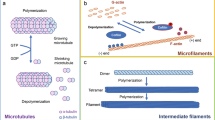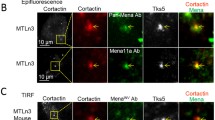Abstract
Motility and adhesiveness are regulated by a multitude of factors, including cytoskeletal polymerization and phosphorylation of cytoskeletal and associated proteins. The metastatic Lewis lung carcinoma variant, LLC-LN7, was highly motile in vitro and had lower levels of the serine/threonine protein phosphatase PP-2A than did the nonmetastatic variant, LLC-C8. Reducing PP-2A activity of the nonmetastatic cells pharmacologically or with catalytic (Cα) subunit antisense increased their in vitro motility. Nonmetastatic LLC-C8 cells had a greater proportion of polymerized tubulin which co-purified with PP-2A as compared to the metastatic LLC-LN7 cells. The PP-2A that was associated with the microtubules of these cells showed similar ratios of the Aα structural subunit to the Cα/β catalytic subunits. In contrast, the proportion of the regulatory subunit B56α was lower in the nonmetastatic LLC-C8 cells as compared to the metastatic LLC-LN7 cells. These studies show the role of PP-2A in restricting the motility of nonmetastatic tumor cells and suggest that the loss of this regulatory control in metastatic LLC-LN7 cells may be due to both a reduction in microtubule-associated PP-2A and a difference in the composition of the subunits of PP-2A that is associated with the microtubules.
Similar content being viewed by others
References
Bernstein LR, Liotta LA. Molecular mediators of interactions with extracellular matrix components in metastasis and angiogenesis. Curr Opin Oncol 1994; 6: 106–13.
Wells A. Tumor invasion: Role of growth factor-induced cell motility. Adv Cancer Res 2000; 78: 31–101.
Otto T, Lummen G, Be A et al. Tumor cell motility. A novel therapeutic target in bladder carcinoma, experimental and clinical results. Adv Exp Med Biol 1999; 462: 469–76.
Vadlamudi R, Adam L, Talukder A et al. Serine phosphorylation of paxillin by heregulin-beta1: Role of p38 mitogen activated protein kinase. Oncogene 1999; 18: 7253–64.
Shimao Y, Nabeshima K, Inoue T et al. TPA-enhanced motility and invasion in a highly metastatic variant (L-10) of human rectal adenocarcinoma cell line RCM-1: Selective role of PKC-alpha and its inhibition by a combination of PDBu-induced PKC downregulation and antisense oligonucleotides treatment. Clin Exp Metastasis 1999; 17: 351–60.
Beviglia L, Kramer RH. HGF induces FAK activation and integrinmediated adhesion in MTLn3 breast carcinoma cells. Int J Cancer 1999; 83: 640–9.
Pokorna E, Jordan PW, O'Neill CH et al. Actin cytoskeleton and motility in rat sarcoma cell populations with different metastatic potential. Cell Motil Cytoskel 1994; 28: 25–33.
Lakshmi MS, Parker C, Sherbet GV. Metastasis and associated MTS1 and NM23 genes affect tubulin polymerisation in B16 melanomas: a possible mechanism of their regulation of metastatic behaviour of tumours. Anticancer Res 1993; 13: 299–303.
Button E, Shapland C, Lawson D. Actin, its associated proteins and metastasis. Cell Motil Cytoskel 1995; 30: 247–51.
Imai K, Kumagai S, Nakagawa K et al. Immunolocalization of desmoglein and intermediate filaments in human oral squamous cell carcinomas. Head Neck 1995; 17: 204–12.
Jackson J, Meisinger J, Patel S et al. Protein phosphatase-2A associates with the cytoskeleton to maintain cell spreading and reduced motility of nonmetastatic Lewis lung carcinoma cells; the loss of this regulatory control in metastatic cells. Invasion Metastasis 1997; 17: 199–209.
Maier GD, Wright MA, Lozano Y et al. Regulation of cytoskeletal organization in tumor cells by protein phosphatases-1 and-2A. Int J Cancer 1995; 61: 51–4.
Metz R, Vellody K, Patel S et al. Vitamin D3 and ceramide reduce the invasion of tumor cells through extracellular matrix components by elevating protein phosphatase-2A. Invasion Metastasis 1997; 16: 280–90.
Maier GD, Vellody K, Meisinger J et al. Protein kinase A regulates Lewis lung carcinoma adherence to extracellular matrix components and spontaneous metastasis. Clin Exp Metastasis 1996; 14: 322.
Meisinger J, Patel S, Vellody K et al. Protein phosphatase-2A association with microtubules and its role in restricting the invasiveness of human head and neck squamous cell carcinoma cells. Cancer Lett 1997; 111: 87–95.
Young MR. Protein phosphatases-1 and-2A regulate tumor cell migration, invasion and cytoskeletal organization. Adv Exp Med Biol 1997; 407: 311–8.
McCright B, Rivers AM, Audlin S et al. The B56 family of protein phosphatase 2A (PP2A) regulatory subunits encodes differentiationinduced phosphoproteins that target PP2A to both nucleus and cytoplasm. J Biol Chem 1996; 271: 22081–9.
Goldberg Y. Protein phosphatase 2A: Who shall regulate the regulator? Biochem Pharmacol 1999; 57: 321–8.
Inoue R, Usui H, Tanabe O et al. Studies on functions of the 63-kDa A-and 74-kDa B'(delta)-regulatory subunits in human erythrocyte protein phosphatase 2A: Dissociation and reassociation of the subunits. J Biochem (Tokyo) 1999; 126: 1127–35.
Kamibayashi C, Lickteig RL, Estes R et al. Expression of the A subunit of protein phosphatase 2A and characterization of its interactions with the catalytic and regulatory subunits. J Biol Chem 1992; 267: 21864–72.
Hiraga A, Tamura S. Protein phosphatase 2A is associated in an inactive state with microtubules through 2A1-specific interaction with tubulin. Biochem J 2000; 346 (2): 433–9.
Young MRI, Duffie GP, Lozano Y et al. Association of a functional prostaglandin E2-protein kinase A coupling with responsiveness of metastatic Lewis lung carcinoma variants to prostaglandin E2 and to prostaglandin E2-producing nonmetastatic Lewis lung carcinoma variants. Cancer Res 1990; 50: 2973–8.
Wadzinski BE, Eisfelder BJ, Peruski LF, Jr et al. NH2-terminal modification of the phosphatase 2A catalytic subunit allows functional expression in mammalian cells. J Biol Chem 1992; 267: 16883–8.
Favre B, Zolnierowicz S, Turowski P et al. The catalytic subunit of protein phosphatase 2A is carboxyl-methylated in vivo. J Biol Chem 1994; 269: 16311–7.
Cohen P. The structure and regulation of protein phosphatases. In Nishizuka Y (ed): The Biology and Medicine of Signal Transduction. New York: Raven Press 1990; 230–5.
Cohen P. Classification of protein-serine/threonine phosphatases: identification and quantitation in cell extracts. Methods Enzymol 1991; 201: 389–427.
Hardie DG, Haystead AJ, Sim ATR. Use of okadaic acid to inhibit protein phosphatases in intact cells. Methods Enzymol 1991; 201: 469–76.
Dobrowsky RT, Kamibayashi C, Mumby MC et al. Ceramide activates heterotrimeric protein phosphatase 2A. J Biol Chem 1993; 268: 15523–30.
Okazaki T, Bielawska A, Bell RM et al. Role of ceramide as a lipid mediator of 1α,25-dihydroxyvitamin D3-induced HL-60 cell differentiation. J Biol Chem 1990; 265: 15823–31.
Price NE, Wadzinski B, Mumby MC. An anchoring factor targets protein phosphatase 2A to brain microtubules. Brain Res Mol Brain Res 1999; 73: 68–77.
Sontag E, Nunbhakdi-Craig V, Lee G et al. Molecular interactions among protein phosphatase 2A, tau, and microtubules. Implications for the regulation of tau phosphorylation and the development of tauopathies. J Biol Chem 1999; 274: 25490–8.
Strack S, Chang D, Zaucha JA et al. Cloning and characterization of B delta, a novel regulatory subunit of protein phosphatase 2A. FEBS Lett 1999; 460: 462–6.
Francia G, Poulsom R, Hanby AM et al. Identification by differential display of a protein phosphatase-2A regulatory subunit preferentially expressed in malignant melanoma cells. Int J Cancer 1999; 82: 709–13
Author information
Authors and Affiliations
Rights and permissions
About this article
Cite this article
Young, M.R.I., Liu, S.W. & Meisinger, J. Differences in association of the serine/threonine protein phosphatase PP-2A with microtubules of metastatic and nonmetastatic tumor cells. Clin Exp Metastasis 18, 407–413 (2000). https://doi.org/10.1023/A:1010934106651
Issue Date:
DOI: https://doi.org/10.1023/A:1010934106651




